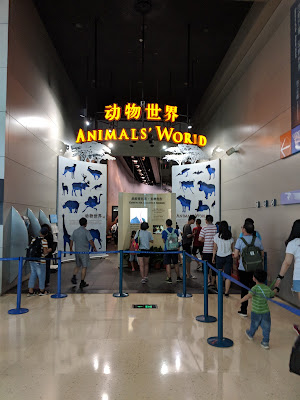It was my last day in Shanghai. I had to make it count. So I set my sights on the
Shanghai Science and Technology Museum!
 |
| It's really big. I couldn't find an angle that would fit the whole thing in one picture, so here's the central 1/5. |
As a matter of national impression, China really, really wants you to see it as a technological wonderland in the same way South Korea, and to a greater extent Japan, have managed to position themselves. And where there's a strong enough profit motive to do it, they generally succeed. For example:
 |
| This here is a vending machine you can only interact with by using your phone. You scan the QR code at the top and it takes you to a website that handles all ordering/payment. Unless you don't have a Chinese phone, like me, in which case you find another vending machine. |
There's no arguing how effective phone-based payments have been at transforming transactions at every level of society. From the lowliest street vendor to the fanciest department stores, nearly all currency exchanges take place by phone. When I arrived, cash in hand, I was told I would seem like a bit of bumpkin, and while nobody was actually annoyed by my old-fashioned paper money, it definitely slowed things down compared to everybody else.
I mean,
beggars accept e-payments. It's that ubiquitous. So I was understandably excited about going to see this museum and uncovering just what other technological marvels China had been hiding in its expansive, Qin Dynasty-era sleeves.
Well, it turns out fully 1/3 of the museum was dedicated to nature, in the aspect of a natural history section. Which, while pretty cool, is basically the opposite of science and technology...
 |
| I came to China to see panda...sculptures. |
And the natural history area was easily twice as crowded as the rest of the museum. I've heard unimpressive things about the Shanghai zoo, but at least it has one. It also has its own
natural history museum. I mean, I didn't even see any dinosaurs at this place.
But at least it had a spider wing.
 |
| Surprisingly mobbed! |
And a temperature-controlled rainforest section, which in Shanghai just means they turned off the A/C.
 |
| Naturally, it contains sculptures of giant insects doing battle, because...science! |
There were a lot more animal exhibits than just the panda, naturally, and I got a slight chuckle from the prominence the moose got in the North America exhibit. All the Chinese tourists were pointing excitedly at it. Moose are a big deal no matter the locale, it seems.
 |
| Turkey fight! |
I eventually got tired of animals and wandered over to the rest of the museum, to see what they had to offer that was actually related to Science and Technology. The rest of the exhibits were pretty cool, but roughly on the level of scientific rigor of what they offer at the Franklin Institute (including four IMAX theaters). That's not a bad thing, though! It's just right for kids. And the robot exhibit finally had some of what I was looking for.
 |
| You can compete in archery with a robot, for some reason! The robot wins. |
They also had CALISTHENICS ROBOT (built cars) and RISK ELIMINATING ROBOT (blows up land mines, or prepares actuarial tables).
 |
| If you want to learn more about robots, check out these knockoff Transformers toys in the gift shop! |
There were many more exhibits, all
pretty fun, but it would take forever to go through them all. However, the museum did give me the perfect way of explaining China's relationship with technology.
There is an extensive waiting area in front of the museum. If you look at the picture of the front again, you'll see a covered, fenced-in area in the lower right. That's normally where the line is:
 |
| And it streeeeeeeetches to the very end of the plaza. |
Now, this particular day was super rainy, so not that many people came out to the museum. There was almost no line to speak of, and nobody was using the covered waiting area at all.
I noticed as I was walking up that there are nozzles which spray mist over the waiting area to help keep people in the line cool. How did I notice?
 |
| Because they were running. |
That's right. Not a soul in line, on a soaking-wet typhoon day, and these misters are still running all-out. It's a wonderful technological solution to a problem that exists basically everywhere in Shanghai. Yet it's been enacted with the broadest, brute-force method, in a way that winds up being wasteful and visibly ridiculous. And the picture doesn't even show the worst of it. When I got out of the metro and stepped into the plaza, I thought it had gotten foggy. But that was just the mist filling the plaza!
Overall, I thought it was a nice museum, and a really great value for money, especially for kids. But it really underlined for me the fundamentally surface-level approach the average Chinese institution takes to solving problems. In a sense, it was a relief to know it wasn't personal.
On to Beijing!






















































